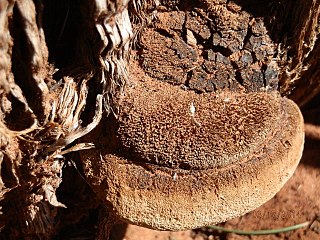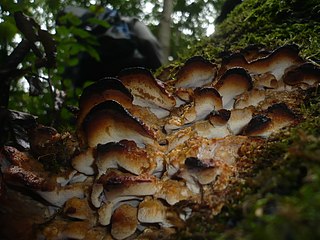
Eurotiomycetes is a large class of ascomycetes with cleistothecial ascocarps within the subphylum Pezizomycotina, currently containing around 3810 species according to the Catalogue of Life. It is the third largest lichenized class, with more than 1200 lichen species that are mostly bitunicate in the formation of asci. It contains most of the fungi previously known morphologically as "Plectomycetes".

Junghuhnia is a genus of crust fungi in the family Steccherinaceae. It was circumscribed by Czech mycologist August Carl Joseph Corda in 1842. The generic name honours German-Dutch botanist Franz Wilhelm Junghuhn.
Alexey Nikolayevich Spirin was a Russian football referee. He refereed one match in the 1990 FIFA World Cup in Italy and the opening game of Euro 1992. Spirin was born in Ruzayevka, Mordovian ASSR, Russian SFSR, Soviet Union on 4 January 1952, and died on 31 January 2024, at the age of 72.

Postia is a genus of brown rot fungi in the family Fomitopsidaceae.

Antrodia is a genus of fungi in the family Fomitopsidaceae. Antrodia species have fruit bodies that typically resupinate, with the hymenium exposed to the outside; the edges may be turned so as to form narrow brackets. Most species are found in temperate and boreal forests, and cause brown rot.

Sarcodontia is a genus of toothed fungi in the family Meruliaceae. It was circumscribed by Hungarian–Croatian mycologist Stephan Schulzer von Müggenburg in 1866, with Sarcodontia mali as the type species.

Aurantiporus is a genus of poroid fungi in the family Meruliaceae. Circumscribed by American mycologist William Alphonso Murrill in 1905, the genus contains five species found mostly in northern temperate regions. Molecular analysis of several Aurantiporus species suggests that the genus is not monophyletic, but some other related polypore species need to be sequenced and studied before appropriate taxonomic changes can be made. In 2018, Viktor Papp and Bálint Dima proposed a new genus Odoria to contain Aurantiporus alborubescens based on multigene phylogenetic analyses. The generic name is derived from the Latin aurantius ("orange") and the Ancient Greek πόρος (pore).

Pyrofomes is a genus of fungi in the family Polyporaceae. The genus was circumscribed by Czech mycologists František Kotlaba and Zdenek Pouzar in 1964. The type species, Pyrofomes demidoffii, was once considered a widespread species with a distribution that included East Africa, Middle Asia, Europe, and North America. DNA evidence demonstrated that North American collections represented a lineage that was different than European collections. The North American sibling was reinstated as P. juniperinus in 2017.
Heterochaete is a genus of fungi in the order Auriculariales. Species produce effused, gelatinous, waxy, or leathery basidiocarps on wood, partly or wholly covered in small sterile spines or pegs. The presence of these sterile spines distinguishes the genus from Exidiopsis, species of which are microscopically similar but have smooth basidiocarps.

Corallina is a genus of red seaweeds with hard, abrasive calcareous skeletons in the family Corallinaceae. They are stiff, branched plant-like protists with articulations. Corallina, like all red algae, are not considered plants, despite being photosynthetic.

František Kotlaba was a Czech botanist and mycologist.

Cerinomyces is a genus of fungi in the order Dacrymycetales. Species are saprotrophs and occur on dead wood. As originally conceived, the genus comprised species of the Dacrymycetes having effused, corticioid basidiocarps. Molecular research, based on cladistic analysis of DNA sequences, has however shown that this circumscription is not valid. As a result, the genus now contains some species having corticioid basidiocarps and some additional species with gelatinous, pustular basidiocarps. Around 30 species have been described worldwide.

Frantisekia is a genus of wood-decay fungi in the family Steccherinaceae.
Truncospora is a genus of 10 species of fungi in the family Polyporaceae.

The Irpicaceae are a family of mostly polypores and crust fungi in the order Polyporales.
Efibula is a genus of 16 species of crust fungi in the family Irpicaceae.
Lilaceophlebia is a genus of three species of crust fungi in the family Meruliaceae. The genus was first proposed by Erast Parmasto in 1968 as a section of the genus Phlebia. Viacheslav Spirin and Ivan Zmitrovich elevated the taxon to generic status in 2004.

Massalongia is a genus of lichen-forming fungi in the family Massalongiaceae. It has four species. The genus was circumscribed by German lichenologist Gustav Wilhelm Körber in 1855, with M. carnosa assigned as the type species.
Fibricium is a genus of fungi belonging to the family Repetobasidiaceae.

Metatrichia is a genus of slime moulds within the family Trichiaceae. Circumscribed in 1964 by Bruce Ing, the genus currently contains six species.














